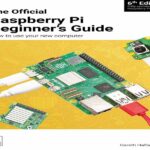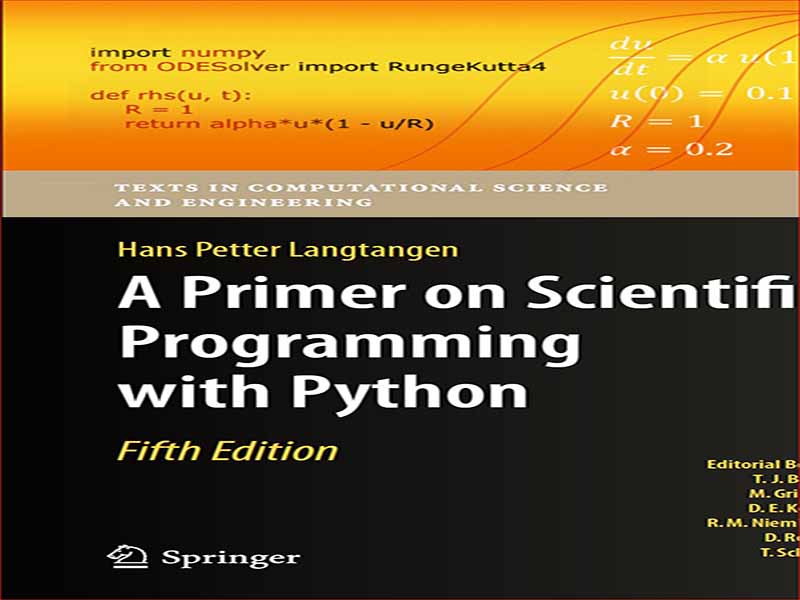- عنوان کتاب: A Primer on Scientific Programming with Python
- نویسنده: Hans Petter Langtangen
- حوزه: برنامه نویسی پایتون
- سال انتشار: 2016
- تعداد صفحه: 942
- زبان اصلی: انگلیسی
- نوع فایل: pdf
- حجم فایل: 8.71 مگابایت
هدف این کتاب آموزش برنامه نویسی کامپیوتر با استفاده از مثال هایی از ریاضیات و علوم طبیعی است. ما استفاده از زبان برنامه نویسی پایتون را انتخاب کرده ایم زیرا قدرت بیانی قابل توجهی را با نحو بسیار تمیز، ساده و فشرده ترکیب می کند. یادگیری پایتون آسان است و برای مقدمه ای بر برنامه نویسی کامپیوتر بسیار مناسب است. پایتون نیز کاملا شبیه به MATLAB است و زبان خوبی برای انجام محاسبات ریاضی است. ترکیب Python با زبان های کامپایل شده مانند Fortran، C و C++ که زبان های پرکاربرد برای محاسبات علمی هستند، آسان است. مثالهای این کتاب برنامهنویسی را با برنامههای کاربردی در ریاضیات، فیزیک، زیستشناسی و امور مالی ادغام میکند. انتظار می رود خواننده دانش حساب پایه تک متغیری را که در برنامه های فشرده ریاضی در دبیرستان ها تدریس می شود، داشته باشد. مسلماً گذراندن یک دوره حسابداری دانشگاهی به صورت موازی، ترجیحاً شامل هر دو جنبه کلاسیک و عددی حساب دیفرانسیل و انتگرال، یک مزیت است. اگرچه به شدت مورد نیاز نیست، پیشینه فیزیک دبیرستان بسیاری از مثال ها را معنادارتر می کند. بسیاری از کتاب های برنامه نویسی مقدماتی کاملاً فشرده هستند و بر روی لیست کردن قابلیت های یک زبان برنامه نویسی تمرکز دارند. با این حال، یادگیری برنامه نویسی یادگیری نحوه تفکر به عنوان یک برنامه نویس است. این کتاب تمرکز اصلی خود را بر روی فرآیند تفکر، یا معادل آن: برنامه نویسی به عنوان تکنیک حل مسئله دارد. به همین دلیل است که بیشتر صفحات به مطالعات موردی در برنامه نویسی اختصاص دارد که در آن یک مشکل را تعریف می کنیم و نحوه ایجاد برنامه مربوطه را توضیح می دهیم. ساختارهای جدید و سبک های برنامه نویسی (آنچه می توانیم تئوری بنامیم) نیز معمولاً از طریق مثال ها معرفی می شوند. توجه ویژه ای به تأیید برنامه ها و یافتن خطاها می شود. این موضوعات برای نرم افزارهای ریاضی بسیار سخت است، زیرا خطاهای تقریب عددی اجتناب ناپذیر احتمالاً با اشتباهات برنامه نویسی مخلوط می شوند.
The aim of this book is to teach computer programming using examples from mathematics and the natural sciences. We have chosen to use the Python programming language because it combines remarkable expressive power with very clean, simple, and compact syntax. Python is easy to learn and very well suited for an introduction to computer programming. Python is also quite similar to MATLAB and a good language for doing mathematical computing. It is easy to combine Python with compiled languages, like Fortran, C, and C++, which are widely used languages for scientific computations. The examples in this book integrate programming with applications to mathematics, physics, biology, and finance. The reader is expected to have knowledge of basic one-variable calculus as taught in mathematics-intensive programs in high schools. It is certainly an advantage to take a university calculus course in parallel, preferably containing both classical and numerical aspects of calculus. Although not strictly required, a background in high school physics makes many of the examples more meaningful. Many introductory programming books are quite compact and focus on listing functionality of a programming language. However, learning to program is learning how to think as a programmer. This book has its main focus on the thinking process, or equivalently: programming as a problem solving technique. That is why most of the pages are devoted to case studies in programming, where we define a problem and explain how to create the corresponding program. New constructions and programming styles (what we could call theory) is also usually introduced via examples. Particular attention is paid to verification of programs and to finding errors. These topics are very demanding for mathematical software, because the unavoidable numerical approximation errors are possibly mixed with programming mistakes.
این کتاب را میتوانید از لینک زیر بصورت رایگان دانلود کنید:



































نظرات کاربران